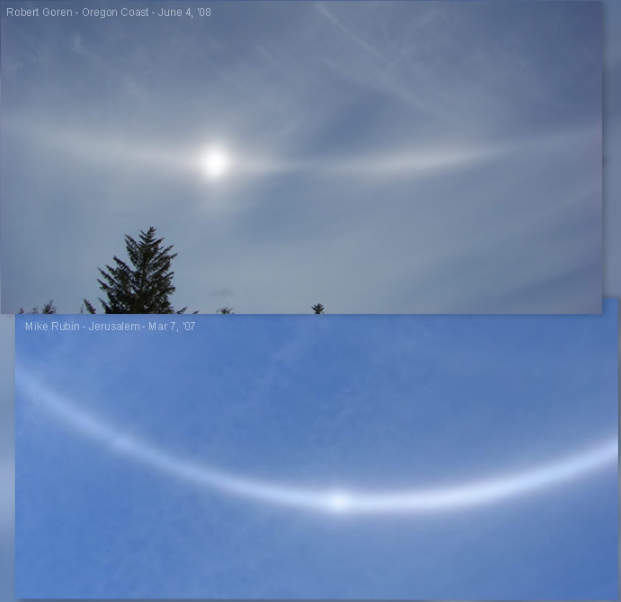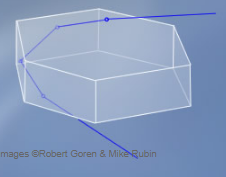White Parhelia
White Parhelia: A Closer Look at These Rare Atmospheric Phenomena
When it comes to atmospheric optics, one of the lesser-known phenomena is the occurrence of white parhelia. While most people are familiar with the colorful sundogs and 22° parhelia, which are seen as vibrant patches of light approximately a hand's span from the sun, white parhelia are often overlooked due to their lack of distinct colors. In this article, we will delve into the intricacies of white parhelia, exploring their formation, characteristics, and rarity.
White parhelia are formed by plate crystals, which allow light to enter through the top face, reflect internally from two side faces, and exit through the lower face. This specific path of light results in a deflection angle of 120°, regardless of the crystal's orientation. Unlike other atmospheric phenomena that display vibrant colors, such as sundogs, the color dispersions at the entry and exit points of the ray cancel each other out, resulting in a white halo.
To create a white parhelion, several conditions must be met. The crystal must have optically perfect faces, meaning they are free from internal defects or impurities. Additionally, the crystal must be relatively thick to allow for the desired light deflection. These requirements make the formation of white parhelia quite rare, as finding crystals that meet all these criteria is a challenge.
The rarity of white parhelia is further highlighted by their resemblance to clouds. Since they lack distinct colors, these phenomena can easily be mistaken for ordinary clouds by casual observers. This similarity often leads to white parhelia being overlooked or disregarded. However, those who take a closer look and observe the parhelic circle may be fortunate enough to spot these elusive white patches of light.
While white parhelia are generally devoid of color, there have been instances where they exhibit subtle hues. These instances are explored in the next OpticsPOD, where researchers and enthusiasts share their observations and insights into the phenomenon. The study of these color variations adds another layer of complexity to the understanding of white parhelia and further emphasizes the need for continued research in atmospheric optics.
In conclusion, white parhelia are a fascinating and often overlooked atmospheric phenomenon. These white patches of light along the parhelic circle are formed by plate crystals and lack the vibrant colors associated with other optical phenomena. Due to their resemblance to clouds and their rarity, white parhelia are often unnoticed by casual observers. However, those with a keen eye for atmospheric optics may be rewarded with the sight of these ethereal white halos. Continued research and observation are essential to unraveling the mysteries surrounding these captivating natural phenomena.

120° Parhelia
Upper image by Robert Goren in Oregon
Lower seen by Mike Rubin in Jerusalem during the great March '07 halo display.
Colourful sundogs, 22° parhelia, a hand's span from the sun are familiar. Less so are the white patches much further along the parhelic circle. 120° parhelia can, as here, be extremely bright but very often they are overlooked because they have no colours to distinguish them from clouds.
They are formed by plate crystals. A ray can enter the top face, reflect internally from two side faces and finally leave through the lower face - path 1,3,8,2. The overall light deflection is always 120° regardless of the crystal orientation. The colour dispersions at ray entry and exit are in opposite directions and cancel to yield a white halo. The ray's route needs several optically perfect faces, freedom from internal defects and thick plates. Rare.
Are the 120° parhelia always lacking in colour? See the next OpticsPOD.

Images ©Robert Goren & Mike Rubin
Note: this article has been automatically converted from the old site and may not appear as intended. You can find the original article here.
Reference Atmospheric Optics
If you use any of the definitions, information, or data presented on Atmospheric Optics, please copy the link or reference below to properly credit us as the reference source. Thank you!
-
<a href="https://atoptics.co.uk/blog/white-parhelia/">White Parhelia</a>
-
"White Parhelia". Atmospheric Optics. Accessed on November 25, 2024. https://atoptics.co.uk/blog/white-parhelia/.
-
"White Parhelia". Atmospheric Optics, https://atoptics.co.uk/blog/white-parhelia/. Accessed 25 November, 2024
-
White Parhelia. Atmospheric Optics. Retrieved from https://atoptics.co.uk/blog/white-parhelia/.